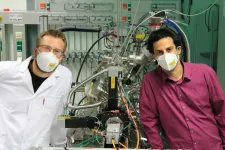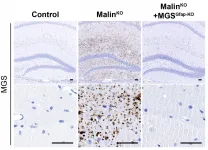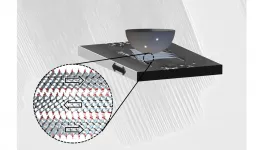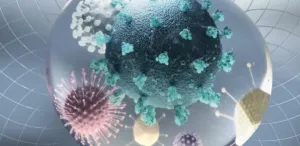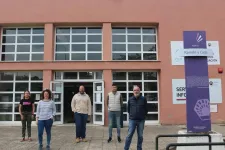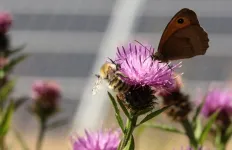Base editors flex sights on sickle-cell disease
2021-04-20
(Press-News.org) Researchers at Beam Therapeutics have developed a redesigned base editor that shows considerable promise in directly repairing the single-base mutation that causes sickle-cell disease (SCD). Many strategies are being pursued to harness genome editing approaches including CRISPR to treat patients with SCD and related hemoglobinopathies. The most advanced method in the clinic involves targeting an upstream regulatory pathway to switch on expression of the fetal hemoglobin gene but does not target the SCD mutation directly.
Writing in the April issue of The CRISPR Journal, a team at Beam Therapeutics, led by Ian Slaymaker and Giuseppe Ciaramella, describe the successful repair of the SCD point mutation by using a redesigned base editor. The group developed a series of inlaid base editors (IBEs) by taking the deaminase portion of the base editor and inserting it into different parts of the Cas9 protein. This architecture provided a more flexible editing "window" that allowed the researchers to target the key mutation.
SCD is caused by an A-to-T mutation in the beta-globin gene resulting in a Glu-to-Val substitution. Base editing cannot reverse the SCD mutation back to the normal gene sequence but in this case, a substitution from T to G gives rise to a rare benign variant called HbG-Makassar (first described in 1970 in a young male living in Makassar, Sulawesi.)
"This paper is a great illustration of the power of CRISPR, combining the base-editing toolbox development aspect and showcasing the therapeutic potential of this modality for a broadly relevant genetic disease," commented Rodolphe Barrangou, PhD, Editor-in-Chief of The CRISPR Journal.
The study is discussed in an accompanying "First Cut" co-authored by Anna Cereseto, T.J. Cradick (Excision Therapeutics), and The CRISPR Journal Executive Editor Kevin Davies.
INFORMATION:
ELSE PRESS RELEASES FROM THIS DATE:
2021-04-20
In a study conducted at the University of Helsinki, researchers found a cause for severe epilepsy resulting in death in Parson Russell Terrier puppies at a few months of age. A change in the PITRM1 gene can lead to a dysfunction of mitochondria, the cellular energy pumps. Concurrently, amyloid-β accumulation and widespread neurodegeneration associated with Alzheimer's disease were identified in the puppies' brains. Changes to the PITRM1 gene in humans also cause a severe but slowly progressing brain disease.
Some Parson Russell Terrier puppies were seen to suddenly develop epileptic seizures at 6 to 12 weeks of age. The disease progressed very rapidly, in a matter of hours in the worst cases, to a situation where the seizures were continuous and unresponsive to medication.
"All ...
2021-04-20
Exposure to certain endocrine-disrupting chemicals could elevate the risk of breast cancer, according to a new comprehensive systematic review of epidemiological research. However, for many chemicals, evidence is inconsistent or still limited. The review was carried out by researchers at the universities of Hong Kong and Eastern Finland and published in Critical Reviews in Food Science and Nutrition.
Endocrine-disrupting chemicals (EDCs) can interfere with the body's hormonal system, also called the endocrine system, and are widely present in the environment. They originate from a variety of ...
2021-04-20
If the CO2 content of the atmosphere is not to increase any further, carbon dioxide must be converted into something else. However, as CO2 is a very stable molecule, this can only be done with the help of special catalysts. The main problem with such catalysts has so far been their lack of stability: after a certain time, many materials lose their catalytic properties.
At TU Wien, research is being conducted on a special class of minerals - the perovskites, which have so far been used for solar cells, as anode materials or electronic components rather than for their catalytic properties. Now scientists at TU Wien have succeeded in producing a special perovskite that is excellently suited as ...
2021-04-20
As we accumulate more and more gene-sequencing information, cell-type databases are growing in both size and complexity. There is a need to understand where different types of cells are located in the body, and to map their gene expression patterns into specific locations in tissues and organs. For example, a gene can be actively expressed in one cell while suppressed in another.
One way of mapping genes into tissues is a technique called in situ hybridization. Simply put, a target gene is tagged ("hybridized") with a fluorescent marker within the sections of the tissue it is located in (the "in situ" part). The sections are then visualized under a specialized microscope to see where the gene "lights up". Consecutive photographs of each section are then put together to generate a ...
2021-04-20
Lafora disease is an inherited neurodegenerative condition that initially develops with seizures in adolescence and evolves with progressive degeneration of the nervous system to death, about ten years after its onset. It is characterised by the accumulation of abnormal glycogen aggregates called Lafora bodies in the brain. There is currently no treatment for this condition, although some therapies are being tested in clinical trials.
Led by Dr. Joan Guinovart, emeritus professor of the University of Barcelona (UB) and also group leader of CIBERDEM, the Metabolic Engineering lab at IRB Barcelona has discovered that Lafora bodies that accumulate in glial cells, which are essential for the proper ...
2021-04-20
You can lubricate a bicycle chain with oil, but what do you do with a Mars rover or a red-hot conveyor belt in the steel industry? Very special nanomaterials have now been studied by the TU Wien together with research groups from Saarbrücken (Germany), Purdue University in the USA and the Universidad de Chile (Santiago, Chile).
The material class of MXenes (pronounced "maxene") has caused quite a stir in recent years in connection with novel battery technologies. But it now turns out that they are also an excellent solid lubricant that is extremely durable and performs its task even under the most difficult conditions. These remarkable properties of MXenes have now been published in the renowned journal ACS Nano.
Like a stack of sheets of paper
Just ...
2021-04-20
A new type of COVID-19 testing strategy could help streamline the process of identifying cases, tracking variants and detecting co-infecting viruses.
At present, separate assays and complex workflows are involved in each of these three diagnostic procedures, with analyses typically performed in highly specialized facilities. KAUST researchers have now combined all three kinds of tests into a single procedure that should allow for point-of-care tracking of COVID-19 and the many emerging variants of SARS-CoV-2.
"Our all-in-one test provides a promising integrated solution for rapid field-deployable detection and mutational surveillance of pandemic viruses," says stem cell biologist Mo Li, who led the study.
The test involves a portable ...
2021-04-20
Scrobiculariaplana is a type of wedge clam widely found along the coasts and estuariesof northern Europe, the Mediterranean and West Africa. Like other mollusks, it is used as a bioindicator to study pollution in these types of ecosystems, for its ability to accumulate heavy metals and organic pollutants.
A new study has managed to identify the transcriptome and the associated proteome of this bivalve, a finding that could represent an important leap forward in the early detection of pollutants in coastal areas. While the genome is the DNA content comprising the genetic information essential for life, the transcriptome includes only the information on genes that are expressed, while the proteome is the totality of proteins expressed at a given time and under specific conditions. Therefore, ...
2021-04-20
Frequent use of social media may not amount to the same as addiction, according to research at the University of Strathclyde.
The study invited 100 participants to locate specific social media apps on a simulated smartphone screen as quickly and accurately as possible, while ignoring other apps. The participants were varied in the extent and type of their social media use and engagement.
The exercise aimed to assess whether social media users who reported the greatest level of use were more likely to have their attention drawn to the apps through a process known as 'attentional bias,' ...
2021-04-20
Researchers assessing the impact of solar energy development across Europe have come up with ten ways in which the expansion of solar can be shaped to ensure pollinators benefit.
Space-hungry solar photovoltaic (PV) is set to dominate future global electricity supply, but with careful decision making, efforts to secure clean energy need not come at the expense of biodiversity - particularly pollinators which are in sharp decline.
Bees, hoverflies, wasps, beetles, butterflies and moths play a key role in food production, with around 75% of the leading global food crops and 35% of global crop production relying on them to some extent.
Writing in the journal Renewable and Sustainable Energy Reviews, a Lancaster-led team of environmental scientists systematically reviewed the available ...
LAST 30 PRESS RELEASES:
[Press-News.org] Base editors flex sights on sickle-cell disease
